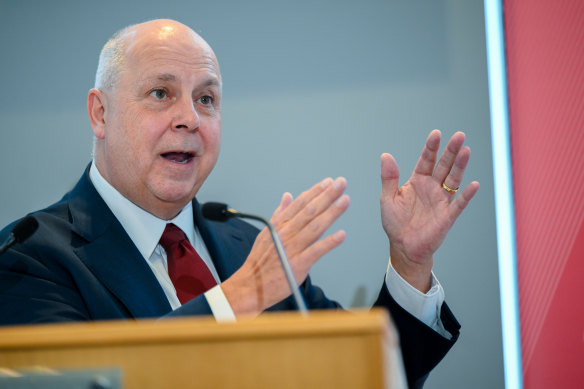Budget doesn’t do enough to tackle debt

Save articles for later
Add articles to your saved list and come back to them any time.
Treasurer Tim Pallas and Premier Daniel Andrews are selling this budget as the government’s most difficult in years. The debt is out of control. The problem needs to be addressed. And according to the government, COVID borrowings are to blame.
Tackling the state’s debt, which is expected to hit $135.4 billion next year, is a worthy pursuit and one The Age supports. This budget, however, does not do enough to address the problem.
The debt is expected to rise to $171.4 billion by 2026-27, according to predictions in the budget. Victoria remains saddled with more debt than any other Australian state. It also has the worst credit rating in the country.
For all the government’s talk of tightening belts and cutting costs, however, it seems most of the pain will be meted out via an additional land tax on more than 800,000 Victorians who own investment properties and holiday homes. Businesses with payrolls over $10 million will also take a hit.
The government, for its part, will continue spending big on infrastructure. Despite public service job cuts, the overall public service wage bill will continue to grow.
In his ninth budget, Pallas has pulled down hard on the revenue lever, but as Josh Gordon reports today, this budget barely puts a dent in the state’s debt burden. This is evident from the graph below. To suggest that it does, or that it is tough, is a false narrative.
As credit ratings agency Moody’s pointed out, the delivery of the government’s capital works projects on time and on budget will have a far greater impact on the state’s economic health. And things aren’t looking good on that front.
The key revenue measure in this budget, increased property taxes on investors and businesses, reduces the current tax-free threshold on second and subsequent properties to a land value of just $50,000, beyond which general taxpayers will pay a fixed tax of up to $975 plus an additional percentage levy on land valued over $300,000. Pallas estimates the average increase will be $1300 a year for the $650,000 landholding component on a typical $1.3 million property.
Treasurer Tim Pallas delivers the budget on Tuesday.Credit: Joe Armao
To carve out the pandemic proportion of the government’s debt and to make wealthier property owners and businesses pay for it is a politically savvy move from a government that has made a habit of targeting big business and whose ability to raise additional revenue is largely limited to land and payroll taxes. Nor is it surprising from a treasurer whom this masthead once depicted as Robin Hood, shaking down a wealthy businessman for loose change.
It is, though, still an extraordinary and divisive impost that will affect, according to Pallas, some 860,000 taxpayers and 5 per cent of businesses.
The justification is that property owners can afford it, after years of capital growth and with rents now surging on a record low vacancy rate. The measure, Pallas said on Tuesday, is “targeted at those with the greatest ability to pay”.
Had some of the funds been overtly steered into affordable housing or a scheme to help young renters in essential professions, we might have been able to support it. But there is nothing here to help first home buyers. Conversely, there must be a strong likelihood that landlords will feel pressure to raise rents even higher. Pallas claimed on Tuesday that this was impossible as the market would not bear it.
Ultimately, someone is going to have to bear some pain to arrest the soaring debt. This is the credit card bill our children will eventually have to pay, at ever-higher rates as our once-cheap debt rolls over, like a fixed-rate mortgage, onto usury contemporary rates.
The government is asking Victorians to start paying off that bill, but it hasn’t yet cut up the credit card.
Patrick Elligett sends an exclusive newsletter to subscribers each week. Sign up to receive his Note from the Editor.
Most Viewed in National
From our partners
Source: Read Full Article

